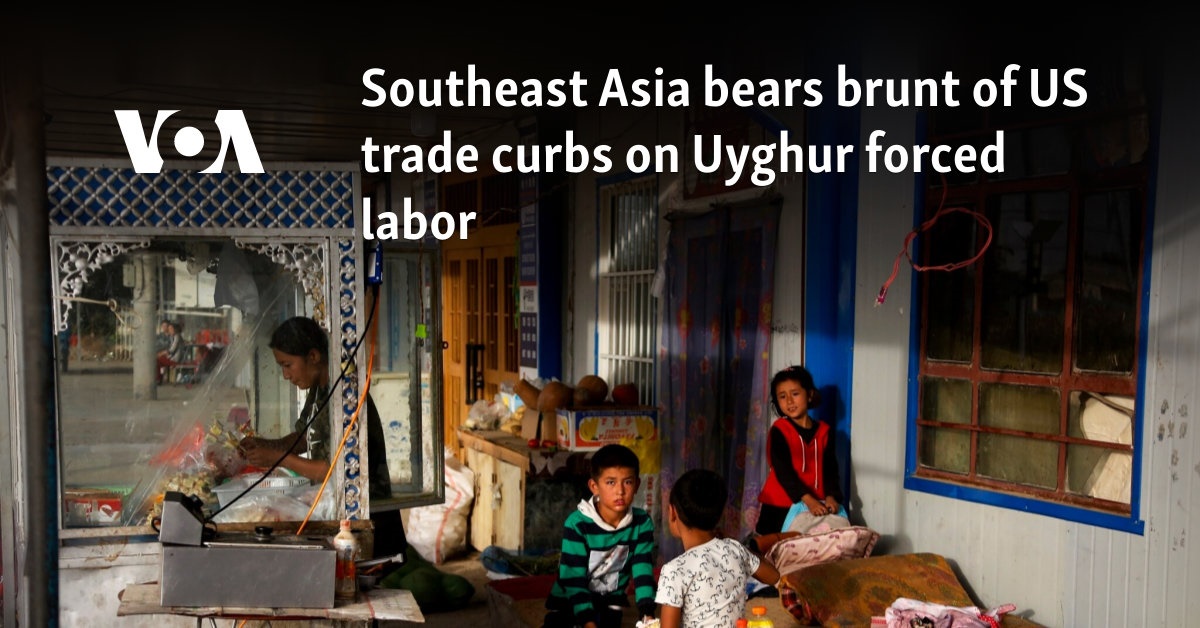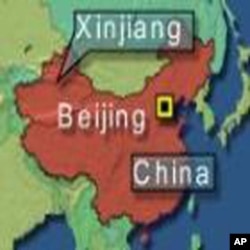Southeast Asia is bearing the increasing burden of US trade restrictions aimed at curbing the forced labor of ethnic Uyghur minorities in China, with billions of dollars in blocked exports, the latest US trade figures show.
Economists and human rights experts attribute the hard hit the region is facing to global supply chains shifting to reroute exports from China through Southeast Asia and to China’s continued dominance in key commodities.
With both powerful forces at play, Southeast Asia is “caught in the middle,” Jayant Menon, a senior fellow at the ISEAS Yusof Ishak Institute in Singapore, told VOA.
The U.S. has detained $3.56 billion in total imports since its Uyghur Forced Labor Prevention Act, or UFLPA, took effect in mid-2022, according to the latest figures from U.S. Customs and Border Protection. About 86% of them, worth more than $3 billion, arrived from Malaysia, Thailand and Vietnam. Only $395 million arrived directly from China.
The law prohibits the importation of products made in whole or in part in China’s Xinjiang Autonomous Region, the historical homeland of the Uyghurs, on the assumption that they have been made with forced labor. While many of the shipments are ultimately allowed to enter the United States, the burden is on the importer to secure their release by proving that the products were produced without forced labor, a process that can take months.
The United States and other governments have accused China of genocide over its treatment of the predominantly Muslim Uighurs, subjecting them not only to forced labor but also mass surveillance and detention, religious persecution and forced sterilization – all denied by Beijing.
Xinjiang is a major source of some raw materials critical to the global supply chain, including 12% of the world’s aluminum, more than a third of polysilicon for solar panels and 90% of cotton produced by China, according to the Coalition to End Forced Labor in the Uyghur Region, a global network of rights groups.
Many of these supply chains now flow through Southeast Asia for reasons beyond just the UFLPA, said Nick Marro, chief Asia economist and global trade analyst for the Economist Intelligence Unit.
“For years, multinational companies — both Chinese and non-Chinese owned — have invested in Southeast Asia to construct supply chains aimed at evading U.S. tariffs,” he told VOA.
While that’s far from the only reason for the influx, he said, “moving some production chains to Vietnam or Thailand, for example, can obscure whether an item could have originally been produced in China.”
“This is not necessarily a foolproof strategy,” Marro said. “U.S. trade authorities are highly sensitive to illegal transshipments and other efforts to circumvent U.S. tariffs. But for some supply chains, cracking down on these activities can be a challenge — especially for products like cotton, which are notoriously difficult to trace.”
Developing supply chains now requires looking beyond exports that arrive directly from China to capture what is made there, said Menon, a former senior trade economist with the Asian Development Bank.
“There is increasing production and value addition in more countries,” he said. “Anything just looking at goods coming from Xinjiang to the United States will not capture the intended target.”
Of the slightly more than $3 billion in exports the U.S. has withheld from Malaysia, Thailand and Vietnam because of the UFLPA, the vast majority, $2.96 billion, has been electronics, including solar panels.
Louisa Greve, global advocacy director for the Washington-based Uyghur Human Rights Project, attributes it to the wave of investment by Chinese solar panel manufacturers into Southeast Asia that started more than a decade ago.
“We don’t know any Uighurs working in Southeast Asia with solar energy, but we know where the polysilicon is going to come from. That’s the problem,” she told VOA. “It’s about the components.”
Greve added that the Southeast Asian countries and companies involved in importing and incorporating the polysilicon into the solar panels they help manufacture and export also risk being complicit in the state-sponsored forced labor that goes into producing it in China .
“Thirty-five percent of the world’s polysilicon, or solar-grade polysilicon, comes from China. It’s up to every manufacturer, like the factories that actually make solar panels in Southeast Asia … to say, ‘We have to be responsible for the raw materials that we use’, she said.
Menon argued that the UFLPA could benefit low-wage countries less tainted by forced labor than China by driving more business their way, but he said Southeast Asia will still struggle to wean itself off Chinese supplies.
“China is still the hub or hub of ASEAN [Association of Southeast Asian Nations] supply chains. It hasn’t changed. There has been some reconfiguration, but by and large China is not going away,” he said.
Menon said “blunt” trade tools like the law can also hurt the countries at the center of these supply chains by driving away existing production and investment, leaving local workers with less work or fewer jobs.
“This [act] is a pretty big move, a pretty massive measure, and so I’d be surprised if it doesn’t have some impact on moving production around,” he said. “If you ban imports like this, inevitably there will be some shifts that shift production in a way that tries to circumvent those bans.”
Marro said the same pressures that drove companies to “de-risk” moving production from China to Southeast Asia years ago could still prove a “double-edged sword.” While the shift has boosted Southeast Asia’s economies, costs could rise as the United States and others begin to look harder at countries that help China avoid its trade restrictions.
Even with only 11 months of fiscal year 2024 reported, U.S. Customs figures show that the UFLPA blocked more imports from Southeast Asia over the past year than the year before.
Marro said enforcement efforts were at “very real risk” of increasing, but added that geopolitics could also intervene.
“As much as U.S. officials want to crack down on Chinese tariff evasion, there is an equal effort to avoid isolating Southeast Asia when it comes to America’s increasingly hawkish strategy toward China,” he said. “This balancing act will characterize the future of US policy towards the region.”

